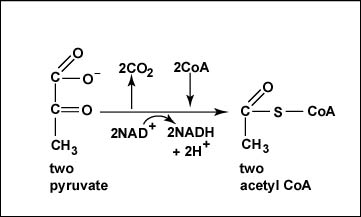
Before the pyruvates from glycolysis can enter the citric acid cycle, they must undergo a transition reaction. Each of the two, 3-carbon pyruvates from glycolysis is converted into a 2-carbon acetyl group with a carboxyl group being removed as CO2. The acetyl group is then attached to coenzyme A to form acetyl coenzyme A (acetyl-CoA). As the two acetyl groups become oxidized to acetyl-CoA, two molecules of NAD+ are reduced to 2NADH + 2H+.
The two molecules of acetyl-CoA then enter the citric acid cycle. The 2NADH molecules that are produced carry electrons to the electron transport system for further production of ATPs by oxidative phosphorylation.